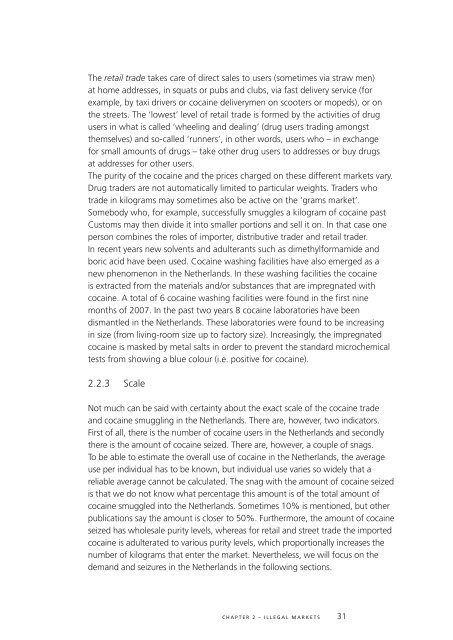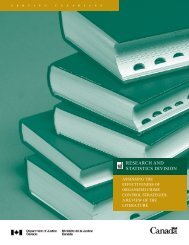National Threat Assessment 2008. Organised Crime - Politie
National Threat Assessment 2008. Organised Crime - Politie
National Threat Assessment 2008. Organised Crime - Politie
You also want an ePaper? Increase the reach of your titles
YUMPU automatically turns print PDFs into web optimized ePapers that Google loves.
The retail trade takes care of direct sales to users (sometimes via straw men)<br />
at home addresses, in squats or pubs and clubs, via fast delivery service (for<br />
example, by taxi drivers or cocaine deliverymen on scooters or mopeds), or on<br />
the streets. The ‘lowest’ level of retail trade is formed by the activities of drug<br />
users in what is called ‘wheeling and dealing’ (drug users trading amongst<br />
themselves) and so-called ‘runners’, in other words, users who – in exchange<br />
for small amounts of drugs – take other drug users to addresses or buy drugs<br />
at addresses for other users.<br />
The purity of the cocaine and the prices charged on these different markets vary.<br />
Drug traders are not automatically limited to particular weights. Traders who<br />
trade in kilograms may sometimes also be active on the ‘grams market’.<br />
Somebody who, for example, successfully smuggles a kilogram of cocaine past<br />
Customs may then divide it into smaller portions and sell it on. In that case one<br />
person combines the roles of importer, distributive trader and retail trader.<br />
In recent years new solvents and adulterants such as dimethylformamide and<br />
boric acid have been used. Cocaine washing facilities have also emerged as a<br />
new phenomenon in the Netherlands. In these washing facilities the cocaine<br />
is extracted from the materials and/or substances that are impregnated with<br />
cocaine. A total of 6 cocaine washing facilities were found in the first nine<br />
months of 2007. In the past two years 8 cocaine laboratories have been<br />
dismantled in the Netherlands. These laboratories were found to be increasing<br />
in size (from living‐room size up to factory size). Increasingly, the impregnated<br />
cocaine is masked by metal salts in order to prevent the standard microchemical<br />
tests from showing a blue colour (i.e. positive for cocaine).<br />
2.2.3 Scale<br />
Not much can be said with certainty about the exact scale of the cocaine trade<br />
and cocaine smuggling in the Netherlands. There are, however, two indicators.<br />
First of all, there is the number of cocaine users in the Netherlands and secondly<br />
there is the amount of cocaine seized. There are, however, a couple of snags.<br />
To be able to estimate the overall use of cocaine in the Netherlands, the average<br />
use per individual has to be known, but individual use varies so widely that a<br />
reliable average cannot be calculated. The snag with the amount of cocaine seized<br />
is that we do not know what percentage this amount is of the total amount of<br />
cocaine smuggled into the Netherlands. Sometimes 10% is mentioned, but other<br />
publications say the amount is closer to 50%. Furthermore, the amount of cocaine<br />
seized has wholesale purity levels, whereas for retail and street trade the imported<br />
cocaine is adulterated to various purity levels, which proportionally increases the<br />
number of kilograms that enter the market. Nevertheless, we will focus on the<br />
demand and seizures in the Netherlands in the following sections.<br />
chapter 2 – Illegal markets<br />
31








